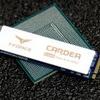Specifications & Features
Specifications & Features
Teamgroup is offering two versions of the C440 (1TB and 2TB). For endurance, our tested 1TB model has been rated at 1800 TBW. The series will be fitted with TLC written 3D NAND flash memory (vertically stacked). This allows the company to offer the proper storage volumes. So instead of using Planar NAND, 3D NAND is used. 3D TLC NAND is physical vertical NAND cell stacking not to be confused with chip stacking in a multi-chip package. In 3D NAND, NAND layers, not chips, are stacked in a single IC. The good news is continued cost reduction, smaller die sizes and more capacity per NAND chip. Also, installed NAND toolsets in the wafer fabs can, for the most part, be reused, thereby extending the useful life of fab equipment. Unleashed by the PCIe 4.0 ready AMD X570 chipset, the M.2 SSD reaches up to an advertised 5000 MB/sec sequential read – ten times the performance of many SATA SSDs, and fifty times faster than some hard disk drives. The unit performance stems from the hugely increased bandwidth of PCIe 4.0 (PCI-Express Generation 4), a feature that will be made available to customers for the first time as part of the AMD X570 chipset and 3rd Generation AMD Ryzen Desktop Processors. Easily fitting into a PCIe 4.0 x4 M.2 slot, the NVMe interface and high-density 3D TLC NAND combine with a Phison PS5016-E16 controller to enable a new level of single-drive SSD performance.
Phison PS5016-E16 controller
For the PS5016-E16 word is that AMD to invested $15 million to help develop the controller in 9 months. The first PCIe 4.0 compliant SSD controller PS5016-E16 introduced by Phison is manufactured with a 28 nm process. It supports flash memory connections up to 8 channels and can support up to 8TB of NAND. A DRAM cache has a capacity of 1/1,000 of the total NAND capacity. In order to support 8TB, two DRAMs (4GB x 2) need to be installed, and so on, so at this stage, 2TB is the maximum capacity of general installed products. The nominal value for such NVMe SSDS are roughly is 5000 MB/s for reads and ~4400MB / s for writes. That is about 40% faster than the high-end class SSD of PCIe 3.0 x4.


